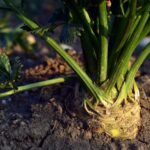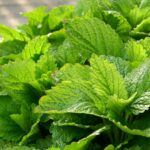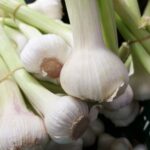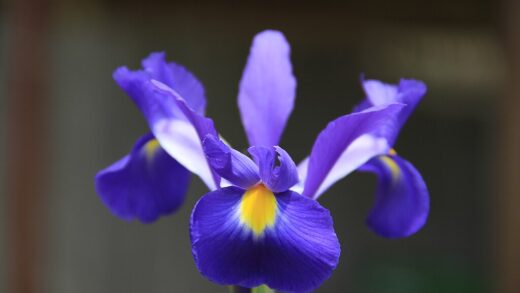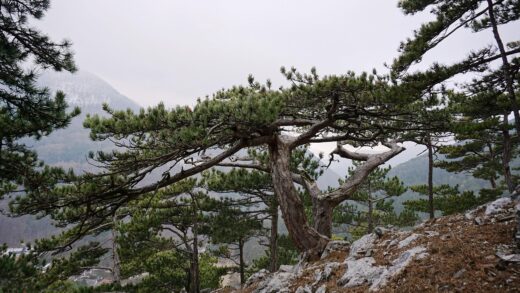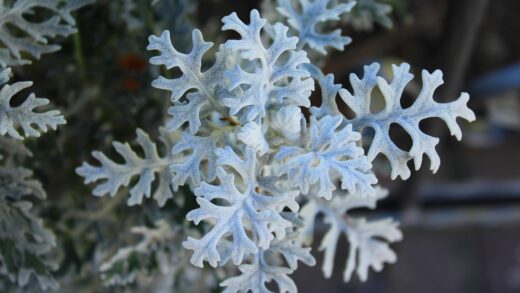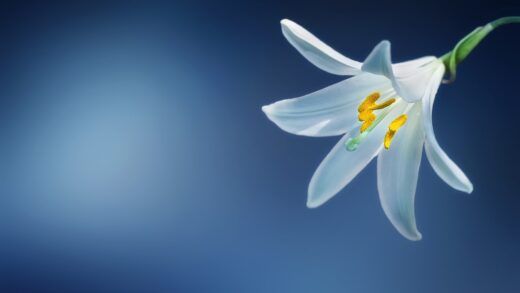Pruning is not a mandatory or essential maintenance task for snow-on-the-mountain, as the plant will naturally grow into a respectable shape on its own in proper conditions. However, strategic trimming and cutting back can be employed to enhance its appearance, encourage a fuller and more compact form, and provide beautiful material for floral arrangements. Any pruning should be done with a clear purpose in mind, whether it is to promote bushier growth early in the season or to neaten the plant’s appearance later on. It is crucial to remember that whenever you cut this plant, you must take precautions against the irritating milky sap it produces by wearing gloves and protective eyewear.
The most common and effective pruning technique for this plant is known as “pinching back.” This is done once, early in the growing season, when the young plants are about six to eight inches tall. This simple act involves using your fingertips or a small pair of shears to remove the top inch or two of the main growing stem. This removes the apical bud, which is responsible for upward growth, and signals the plant to redirect its energy into developing the lateral buds further down the stem. The result is a plant that develops multiple strong stems instead of just one, leading to a much denser, bushier, and more rounded habit.
Mid-season trimming is generally not necessary unless a stem becomes damaged by wind or other physical disturbances. If a branch is broken, it should be pruned back cleanly to the nearest set of healthy leaves or to a main stem. Some gardeners may also choose to do a light shearing in mid-summer if the plants are becoming excessively tall or leggy, although this is often a sign of insufficient light. This type of cutting back should be done with caution, as it can delay or reduce the eventual display of variegated bracts if done too late in the season.
One of the best reasons to cut snow-on-the-mountain is for harvesting. The long, elegant stems with their frosted tops are a unique and stunning addition to cut flower bouquets. When cutting stems for arrangements, select those that are mature and firm, and use a sharp, clean knife or shears. This not only provides you with beautiful material for indoors but also serves to thin out the plant slightly, which can improve air circulation. Remember to sear or dip the cut ends in hot water immediately to stop the flow of sap and prolong their vase life.
The purpose of pruning this plant
While many plants are pruned to control their size, improve their health, or stimulate flowering, the primary purpose of pruning snow-on-the-mountain is almost entirely aesthetic. The main goal of any trimming is to manipulate the plant’s natural growth habit to create a more visually appealing form. A single, unpinched plant can sometimes grow tall and a bit lanky, whereas a pruned plant will be shorter, wider, and significantly denser, resulting in a more impactful mass of variegated foliage later in the season.
More articles on this topic
A key purpose of the early-season pinch is to prevent the plant from becoming top-heavy and floppy. By encouraging the growth of multiple stems from a low base, you are creating a more stable and self-supporting structure. This can be particularly important in windy locations or in soils that are slightly richer than ideal, both of which can lead to taller, weaker growth. A well-branched, bushy plant is much less likely to require staking or other forms of support later in the summer.
Pruning can also be seen as a way to maximize the final floral and foliar display. Although you are removing the initial growing tip, the resulting side shoots will all eventually terminate in their own clusters of flowers and variegated bracts. Therefore, a single pinched plant might produce five or six smaller displays instead of one large one. This creates the illusion of a much fuller plant and a more abundant “snowy” effect across the top of the plant’s canopy.
Finally, pruning in the form of harvesting stems for cut arrangements serves the dual purpose of beautifying both the garden and the home. This selective trimming thins the plant, which can be beneficial for air circulation, while providing unique and long-lasting material for bouquets. It allows the gardener to interact with the plant in a different way, appreciating its beauty up close as well as from a distance in the landscape.
Pinching back young plants for bushier growth
Pinching is a simple but powerful technique that dramatically influences the shape of snow-on-the-mountain. The process should be performed when the plants are still young and actively growing, typically when they have reached a height of about six to eight inches and have several sets of true leaves. Waiting until the plant is too tall will be less effective and can result in a less attractive, high-branching shape. The timing of this one simple action is key to its success.
More articles on this topic
The technique itself is straightforward. Using a clean pair of pruning shears, scissors, or even just your thumb and forefinger, you snip off the top one to two inches of the main, central stem. The cut should be made just above a set of leaves or a leaf node. This removal of the terminal bud, which produces hormones that suppress side growth, allows the dormant buds located at the nodes below the cut to activate. These lateral buds will then grow out into new stems.
The result of this single pinch is a plant that forgoes its natural tendency to grow into a single, tall stalk and instead develops a multi-stemmed, shrub-like form. This creates a much fuller and more robust plant. A pinched plant will be slightly shorter than an unpinched one, but it will be significantly wider and denser. This makes it an excellent technique for creating a cohesive mass planting or a well-rounded border edge.
It is important to note that this should only be done once. Continuously pinching the plant throughout the season is not necessary and would delay the development of the variegated bracts and flowers. A single pinch early in its life is all that is needed to set the plant on a path towards a bushier, more structurally sound, and ultimately more floriferous form. This minimal effort pays significant dividends in the final appearance of the plant.
Deadheading and mid-season trimming
Deadheading, the practice of removing spent flowers, is not a necessary or practical task for snow-on-the-mountain. The actual flowers of the plant are very small, numerous, and inconspicuous, surrounded by the showy variegated bracts. Attempting to remove these tiny, spent blooms would be an incredibly tedious and time-consuming process with little to no aesthetic benefit. The primary visual appeal comes from the bracts, which remain attractive for a long period, long after the small flowers have faded.
Furthermore, a key reason for deadheading other annuals is to prevent them from setting seed, thereby encouraging them to produce more flowers. For snow-on-the-mountain, allowing the plant to set seed is often a desired outcome, as it ensures a supply of plants for the following year through self-seeding. Therefore, letting the natural cycle of flowering and seed production proceed uninterrupted is the standard and recommended practice for this particular plant.
Mid-season trimming or shearing is generally not advised unless there is a specific problem to correct. If, for instance, a plant has become very leggy due to inadequate sunlight, a light shearing of the top few inches could potentially encourage it to branch out. However, this is treating a symptom, not the cause, and the better solution is to ensure the plant is sited correctly in the first place. Any significant cutting back during the middle of the summer risks removing the growth that would soon develop into the prized variegated foliage.
If you must trim the plant mid-season—perhaps to control its spread into a walkway or to remove a damaged stem—do so sparingly. Use sharp, clean pruners to make a clean cut. Be aware that any cut you make will trigger the flow of the irritating milky sap, so wearing gloves is essential. In general, however, it is best to let the plant grow naturally after the initial pinch, as it will typically maintain a pleasing form on its own when grown in the proper conditions.
Using the clippings for floral arrangements
One of the most rewarding reasons to prune snow-on-the-mountain is to harvest its beautiful stems for use in floral arrangements. The elegant, upright stems topped with finely detailed green and white leaves provide a wonderful sense of lightness and texture to bouquets. They can act as a filler, similar to gypsophila (baby’s breath), but with more substance and a more contemporary feel. They combine beautifully with almost any other flower, either complementing soft pastels or providing a striking contrast to bold, vibrant colours.
To harvest, select stems that are mature and firm, with well-developed variegation. Cut them in the cool of the morning when they are fully hydrated. Use a very sharp knife or shears to make a clean cut at your desired length, and immediately take steps to manage the milky sap. The best method is to have a container of very hot water or a candle flame ready. Briefly dipping the cut end of the stem into the hot water or searing it with the flame will stop the flow of sap, which prevents it from fouling the vase water and significantly extends the life of the cutting.
Once conditioned, the stems are ready to be used in your arrangement. They are remarkably long-lasting in a vase, often looking fresh for a week or more if the water is kept clean. Their neutral colour palette makes them incredibly versatile. They can be used to create a cool, all-white and green arrangement, or they can be paired with bold zinnias, dahlias, or salvias to create a high-contrast, late-summer display.
Do not be hesitant to cut from your garden plants. This selective harvesting essentially acts as a form of thinning, which can be beneficial for the parent plant by increasing air circulation through its remaining stems. It is a wonderful way to enjoy the beauty of your garden indoors as well as out. Just be sure to always wear gloves during the harvesting and conditioning process to protect your skin from the irritating sap.
Safety precautions when pruning
Whenever you undertake any form of pruning, pinching, or cutting of snow-on-the-mountain, safety must be your top priority due to the plant’s toxic, milky sap. This latex substance can cause significant skin irritation, ranging from a mild rash to painful blistering, in a reaction known as contact dermatitis. It is absolutely imperative that you wear waterproof gardening gloves to protect your hands from any contact with the sap.
Eye protection is also highly recommended, especially when you are cutting multiple stems. A small, accidental splash of the sap into an eye can cause severe pain, inflammation, and temporary vision problems, requiring immediate medical attention. A simple pair of safety glasses or even regular sunglasses provides a critical barrier that can prevent a painful and dangerous injury. It is a small precaution that is well worth taking.
After you have finished pruning, it is important to clean your tools thoroughly. The sap is sticky and can dry on the blades of your pruners or shears. Wiping the blades with a cloth soaked in rubbing alcohol will effectively remove this residue, preventing you from accidentally coming into contact with it later. This also helps to keep your tools in good condition and prevents the potential spread of any plant diseases, however unlikely with this species.
Finally, be mindful of where the pruned clippings fall. Do not leave them on the lawn where children or pets might play, and be careful when gathering them for disposal. Wash your hands and arms thoroughly with soap and water after you have finished your work, even if you were wearing gloves, just to be safe. By respecting the plant’s natural defenses and taking these simple, common-sense precautions, you can prune and handle your snow-on-the-mountain safely and without any issues.








